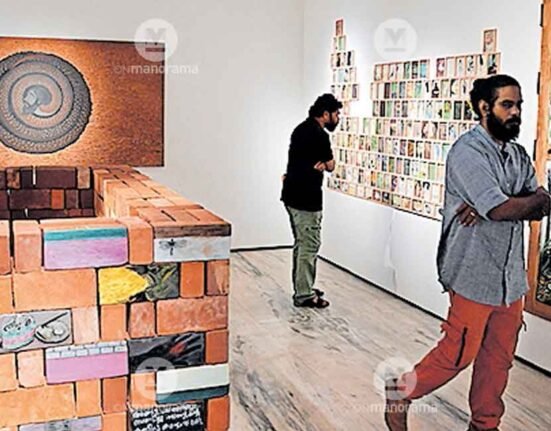You would think that there were dozens of histories of British art out there, along the lines of an art history course I came across titled ‘Caveman to Picasso’. Oddly, there are not, and those that exist cannot always be trusted. This most enjoyable book is an exception.
Bendor Grosvenor says in his introduction, ‘The story of the development of British art is rarely told in a single, chronological account, and partly for this reason, our understanding of how British art evolved, who made it, for whom, and what it represents, has been distorted.’ That is true. One of the few attempts at such an account is Andrew Graham-Dixon’s A History of British Art (1996), a book based on a TV series that, while stimulating, comes with the limitations this entails. More closely resembling Grosvenor’s book in its sweep is The History of British Art (2008), published by Tate and Yale University Press. Each of the three volumes is organised thematically within broad chronological parameters. Reading it is a yo-yo experience. The volume on the ‘Long Middle Ages’ – and they are very long indeed, lasting from 600 until 1600 – is the best. The second, ranging from 1600 to 1870, is not inspiring and contains too many errors of fact. The final volume, taking in the period from 1870 to the 21st century, is a proleptic Tate apologia for abstract and conceptual art, to the neglect of anything figurative.
The great period of British art, roughly the years between Hogarth’s rise and Turner’s death, is particularly ill served. The seeker after truth might well turn to the famous Yale Pelican History of Art series but will find there David H Solkin’s Art in Britain 1660–1815 (2015), touted as ‘the first social history of British art’. If you accept his theory-led speculations, you might like it. If not, you won’t.
Grosvenor’s approach is not so outlandish:
I set out to uncover how British art was created, what made it distinctive, and why it took so long to emerge – that is, the process of its invention … I want to reconsider British art history within the context of Britain’s longer history, its people, and their beliefs and ideas.
That is just what he does. The scope of the book is wide, starting with an incised bone from 10,000 BC (those cavemen…) known as the Creswell Horse and ending in the mid-19th century, by which time British art had finally come to be admired throughout Europe – not least on account of the work of Sir Thomas Lawrence and John Constable (Turner, however ‘modern’ he seems to us, did not count on the continent, where he was considered merely eccentric). Along the way, Grosvenor takes in, with authoritative ease, such highpoints of British art as medieval needlework, Nottingham alabasters and Hilliard’s miniatures. Among many welcome discussions is a superb survey of Van Dyck’s career in England, Grosvenor setting his work in the context of the religious differences of the time (a ‘culture war’) and offering a sensitive interpretation of the role of Archbishop Laud.
Grosvenor’s book is blissfully free of jargon and is elegantly written, with plenty of dry wit and neat turns of phrase. It is also full of fresh observations and ideas, even if, as is inevitably going to be the case in such a survey, the coverage is uneven. This does not matter most of the time, although the role of Richard Wilson in the establishment of modern landscape painting in Britain and Europe is misunderstood (and his date of birth was 1 August 1714 and not, as Grosvenor has it, ‘1712/13’). The key to the revolution effected by Constable in European art was his demonstration of how mundane activities in particular places could be depicted in heroic terms. The Hay Wain, which won the Gold Medal at the Paris Salon of 1824, exemplifies his approach. But Constable’s achievements, like Turner’s – as both artists acknowledged – were founded upon Wilson’s innovations. No Wilson, no Constable or Turner. Wilson also paved the way for the distinctive landscapes of Joseph Wright of Derby, who receives as full a treatment here as any other individual artist. Much of this discussion is, unusually, about landscape painting, a genre in which, Grosvenor claims, ‘a distinctly British art had finally been invented’.
In this context, Grosvenor questions the received view that Edmund Burke’s A Philosophical Enquiry into the Origin of Our Ideas of the Sublime and Beautiful (1757) had a decisive influence upon artists. He argues that if artists did indeed read the book, they tried to prove Burke wrong as much as follow him, and suggests that artists were seeking a ‘religious sublime’ rather than the version put forward by Burke. He states: ‘I do not doubt Burke’s influence in literature. Yet for our story we should again be careful not to overestimate the influence on art of an individual book or writer. The ideas matter more, and they had multiple sources.’ This is a typically shrewd reflection and is a warning that art historians would do well to heed.
An especially tendentious approach to interpreting British art was pioneered by John Barrell in The Dark Side of the Landscape (1980). He observed that the brutal realities of rural poverty are omitted from the landscape paintings of, among others, Gainsborough and Stubbs, and suggested that a kind of conspiracy existed between landowners and artists to conceal the facts. Barrell’s influential book cries out to be confronted – and Grosvenor does this. He offers an alternative interpretation of Stubbs’s rustic scenes, although he misses one important point about them. Stubbs did indeed say that he went to Rome in 1754 ‘to convince himself that nature was & is always superior to art whether Greek or Roman’. But Stubbs surely set out in Haymakers (1785) and Reapers (1785) subliminally to evoke antiquity, in order to elevate his ostensibly humble subject matters. Both compositions are intended to echo the form of a classical frieze and in each the ‘golden ratio’ (1:0.62) is applied. It is no coincidence that Stubbs supplied designs for Josiah Wedgwood’s classicising ceramics.
Nonetheless, Grosvenor cuts through the pointless tangle into which Barrell and his disciples have drawn so many British art historians. In the middle of his discussion of Stubbs’s Haymakers and Reapers he asks this question: ‘Are such pictures evidence of a conspiracy between artists and patrons, or simply a habit? Surely the latter.’ That exemplifies two of the many virtues of this excellent book: it is down to earth and to the point.







